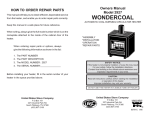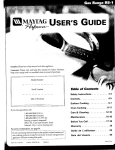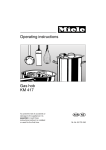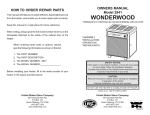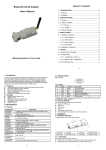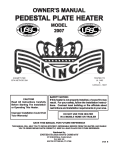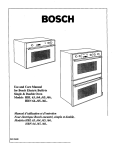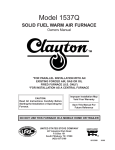Download United States Stove Company 2847 Owner`s manual
Transcript
Owners Manual Model 2847 HOW TO ORDER REPAIR PARTS This manual will help you to obtain efficient, dependable service from the heater, and enable you to order repair parts correctly. WONDERCOAL AUTOMATIC COAL BURNING CIRCULATOR HEATER Keep this manual in a safe place for future reference. When writing, always give the full model number which is on the nameplate attached to the inside of the cabinet door of the heater. When ordering repair parts or options, always give the following information as shown in the list: 1. 2. 3. 4. *ASSEMBLY *INSTALLATION *OPERATION *REPAIR PARTS WONDER COAL The PART NUMBER The PART DESCRIPTION The MODEL NUMBER: 2847 The SERIAL NUMBER:________________ SAFETY NOTICE: If this heater is not properly installed, a house fire may result. For your safety, follow the installation directions. Contact local building or fire officials about restrictions and inspection requirements in your area. Before installing your heater, fill in the serial number of your heater in the space provided above. CAUTION: Read all instructions carefully before starting the installation or operation of this heater. Improper installation may void your warranty. DO NOT USE THIS HEATER IN A MOBILE HOME OR TRAILER United States Stove Company STATES STO TED V NI USSC COMPANY E 227 Industrial Park Rd. P.O.Box 151 South Pittsburg, TN 37380 (423) 837-2100 U United States Stove Company 227 Industrial Park Rd. P.O.Box 151 South Pittsburg, TN 37380 (423) 837-2100 WARNOCK HERSEY R 851171A 3/96 Notes TOOLS AND MATERIAL NEEDED TOOLS MATERIALS Pencil Chimney Connection- 6" Dia. Black 6 Foot Folding rule or tape Tin Snips Steel (24 Ga. minimum): Straight or Corrugated Elbow (as required)* Drill, hand or electric Drill bit, 1/8" dia. 1/2" Sheet Metal Screws 6" Inside Diameter Underwriters (for sheet metal screws) Gloves Laboratories (UL) listed Residential Type and Building Heating Appliance Screwdriver (blade-type) 5/16" Nut Driver or Chimney or lined, 6" existing Masonry Chimney. 5/16" Socket w/Ratchet Floor Protector Material: 3' x 4'-6" as specified on page 4. Furnace Cement (Manufacturer recommends: Rutland Code 78 or Equivalent) * Avoid adjustable elbows, they leak! CIRCULATOR DIMENSIONS Fig. 1 19 1/4 32 1/4 8 5/16 16 1/8 WONDERCOAL 33 1/2 4 1/8 2 23 RULES FOR SAFE INSTALLATION AND OPERATION Read these rules and the instructions carefully. F36 BLOWER KIT An Optional Blower Kit is available for the 2847 Wondercoal automatic coal burning circulator heater. If this kit is not available where you have purchased this Wondercoal heater, you can purchase the F36 Blower Kit directly from the factory. To order contact the United States Stove Company at the address and telephone number given on the back page. SAFETY NOTICE: If this heater is not properly installed, a house fire may result. For your safety, follow the installation directions. Contact local building or fire officials about restrictions and installation inspection requirements in your area. 1. Check local codes. The installation must comply with their rulings. Do not install this heater in a mobile home or trailer. 2. Always connect this heater to a chimney or vent to the outside. Never vent to another room or inside a building. 3. Do not connect a COAL burning heater to an aluminum Type B gas vent. This is not safe and is prohibited by all codes. This heater requires connection to approved chimneys: Either a factory built 6" UL 103HT or a lined and approved and recently inspected and cleaned masonry chimney with a 6" flue, preferably round. A larger masonry flue may be used, so long as the flue-section diameter is not greater than 50 sq. in. The chimney portion (whether factory-built or masonry) must be tall enough to provide sufficient draft and safe exit of smoke and combustion products. Please refer to Page 5. 4. Be sure that your Chimney is safely constructed and in good repair. Have the chimney inspected by the Fire Department or a qualified inspector (such as a Chimney sweep). Your insurance company may be able to recommend a qualified inspector. 5. Inspect chimney connector and chimney twice monthly during the heating season for any deposit of creosote or soot which must be removed. 6. Provide air for combustion from outside the house into the room where the heater is located. If the intake is not in the same room, air must have free access to the room. 7. CAST IRON PARTS MUST BE "SEASONED" TO AVOID CRACKING. BUILD ONLY SMALL FIRES ON FIRST USE. 8. To prevent injury, do not allow anyone to use this heater who is unfamiliar with the correct operation of the heater. Do not allow children to use or in any way operate this heater. CAUTION: DO NOT TOUCH THE HEATER UNTIL IT HAS COOLED. ALWAYS WEAR GLOVES WHEN REFUELING THIS UNIT OR WORKING WITH METAL CABINET PARTS. 22 3 9. For further information on using your heater safely, obtain a copy of the National Fire Protection Association (NFPA) publication "Using Coal and Wood Stoves Safely" NFPA No. HS-10-1978. The address of the NFPA is Battery March Park, Quincy, MA. 02269. 10. Keep the ash pit section free of excess ashes. Do not allow ashes to stack higher than the sides of the ash pan.* 11. DISPOSAL OF ASHES- Ashes should be placed in a metal container with a tight fitting lid. Keep the closed container on a non-combustible floor or on the ground, well away from all combustible materials. Keep the ashes in the closed container until all cinders have thoroughly cooled. The ashes may be buried in the ground or used as fertilizer. 12. CAUTION: The special paints used on your heater may give off some smoke while they are curing during first few fires. Build small fires at first. The metal used in construction of the heater has a light coating of oil. This could give off smoke and/or odors when heater is used for the first couple of times. This should disappear after a short period. Once this burn-off has occurred, it should not reoccur. 13. CARING FOR PAINTED PARTS- This heater has a painted outside jacket, which is durable but will not stand rough handling or abuse. When installing your heater, use care in handling. Clean with soap and warm water when heater is not hot. DO NOT use any harsh chemicals (acids or caustics) or scouring powder, as these wear and dull the finish. 14. KEEP THE FEED DOOR, ASH DOOR AND CABINET DOOR CLOSED AT ALL TIMES EXCEPT WHILE TENDING THE HEATER. DO NOT OVERFIRE THE HEATER. THIS WILL HAPPEN IF THE FEED DOOR, OR PARTICULARLY THE ASH DOOR, IS LEFT OPEN DURING OPERATION. UNDER EXTREME CONDITIONS THIS CAN PRODUCE DANGEROUS RESULTS. AS A MINIMUM, IT WILL ALLOW THE PAINT TO DISCOLOR. 15. Use coal only. DO NOT USE the coal bricks that are manufactured from coal dust and a wax-type binder. *Never allow ashes to contact the grate(s). TROUBLE SHOOTING TIPS FOR MODEL 2847 LOCATING THE HEATER AS A LOCATION IS SELECTED, KEEP THE FOLLOWING IN MIND: 1. The chimney connection should be as possible. The heater must have its own chimney flue. Do not connect this unit to a chimney flue, serving another appliance. If there is no chimney near where you wish to place the heater, you can use a UL 103HT Residential Type and Building Heating Appliance Chimney (Fig. 5, 6, 6A & 6B). 2. Place the heater on solid masonry or solid concrete. When the heater is used on a combustible floor protector of one layer of 3/8" millboard having a thermal conductivity of K=0.84 BTU in./ft. 2 hr. Deg. F with 28-gauge sheet metal or a UL Listed floor protector. Have the floor protector extend 16" beyond the door side of the heater and under the connector pipe in the back. NOTE: BEFORE FIRING HEATER Slide firebricks toward the rear so no gaps remain between them. CAUTION: Keep furnishings and other combustible materials away from the heater. LIST OF PROBLEMS POSSIBLE CAUSE SOLUTION 1. Smoking when feed door is open. A) Insufficient Draft. B) Clogged chimney or chimney connector. A) Set Thermostat high B) Clean Chimney C) Add raincap to chimney 2. Flame spillage when feed door is open. A) Insufficient Draft. B) Smothering fire when adding fresh fuel. A) Set Thermostat high B) Add fuel so as not to smother fire. 3. Creosote build-up A) Thermostat setting too low type fuel. A) Set thermostat higher to attain higher fuel temperatures. This will aid in preventing build-up of creosote. 4. Heater does not heat. A) Blower control set too low. B) Insufficient flue draft. 3. Check Figures 2, 3, and 4. Be sure you have the clearances shown from the heater and the connector pipe to combustible surfaces. If you have a solid brick or stone wall behind your heater, you can place the heater as close as you wish to the wall. If the wall is only faced with brick or stone, treat it as a combustible wall. 8" Fig. 2 21" Fig. 3 WONDERCOAL 20" 16" 52 1/4" NON-COMBUSTIBLE CONSTRUCTION IN ACCORDANCE WITH NFPA 211 20" 44" Fig. 4 19 1/4" 4 3/4" NOTE: DASHED LINES SHOW STRAIGHT UP AND THROUGH THE WALL INSTALLATION 32 1/4" 16" 8" SIDEWALL FLOOR PROTECTOR (TOP VIEW) 4 21 A) Set blower control to a higher temperature. B) Set flue draft CHIMNEY CONNECTION 3 2 19 8 7 5 4 6 14 15 34 36 16 10 13 21 12 18 1 11 9 Do not expect your stove or furnace to create draft. Draft is not a function of the appliance. Draft is purely a function of the chimney. Modern stoves and furnaces are much more airtight and efficient than those of the past; and, therefore require greater draft. A minimum of .05, measured in water column (gauges to measure chimney draft are readily available at stove shops and are economical to purchase or rent) is required for proper drafting to prevent back-puffing, smoke spillage, and to maximize performance. Chimneys perform two functions - one of which is apparent: The chimney provides a means for exhausting smoke and flue gases resulting from combustion of the fuel. Secondarily, though, the chimney provides "Draft" which allows oxygen to be continuously introduced into the appliance, so that proper combustion is possible. As of April 1, 1987, all heaters and furnaces manufactured by United States Stove Company should be installed using a factory built chimney that meets the "Type HT" requirement of UL 103 (when a factory - built chimney is used). IMPORTANT *Size the chimney to the flue outlet on the stove. (6" outlet = 6" I.D. chimney) *Avoid using elbows except as necessary (they reduce draft). *Make sure all horizontal runs of connector pipe go up hill (1/4" elevation for each horizontal foot). 2 FT MIN. 3 FT. MIN. 10 FT. FLUE CONNECTION - NON-COMBUSTIBLE WALL THIMBLE PIPE ELBOW COLLAR 35 REFER TO CHIMNEY MANUFACTURERS PARTS AND INSTRUCTIONS PIPE PIPE 20 25 23 22 27 28 24 33 29 32 28 31 29 17 REPAIR PARTS AUTOMATIC COAL BURNING CIRCULATOR HEATER MODEL 2847 - INTERIOR Two basic types of chimneys are approved for use with solid fuel: Factorybuilt and masonry. Factory-built chimney must comply with UL103HT standard. 26 30 FLOOR PROTECTOR NON-COMBUSTIBLE WALL FLOOR PROTECTOR Fig. 5 Thru-the-Wall Installation 20 Fig. 6 5 REPAIR PARTS LIST - MODEL 2847 (SEE PAGE 20) AUTOMATIC COAL BURNING CIRCULATOR Cathedral Ceiling Installation - Fig. 6A Key No. CHIMNEY CAP MANDATORY 1 2 3 4 5 6 7 8 9 10 11 12 13 14 15 16 17 18 * 19 2 FT MIN. 3 FT. MIN. 10 FT. 11 FT. MIN. REFER TO CHIMNEY MANUFACTURERS PARTS AND INSTRUCTIONS PIPE FLOOR PROTECTOR 20 21 22 Typical Masonry Chimney Installation - Fig. 6B APPROVED COWL 2 FT MIN. 10 FT. MINIMUM 6" MIN. 3 FT. MIN. APPROVED THIMBLE 60" MIN. 23 24 25 26 27 28 29 30 31 32 33 34 35 36 * Description Shaker Handle Second Heat Shield Heat Shield Draft Damper Hinge Pin Draft Damper Frame Base Draft Control Damper Clip Coal Grate Grate Support Firebrick Firebox Front & Rear Liner Flue Collar Flue Collar Gasket Firebrick Retainer Hinge Pin Smoke Curtain Smoke Curtain Bracket Coal Grate Frame Feed Door Assembly Feed Door 1/4-20 Kep Nut Part No. 1 1 1 1 1 1 1 1 1 2 10 1 3 1 1 2 1 1 2 1 40045 22030 22110 17200 40075 67859 67132 83818 40101 22536 89066 68979 40100 23234 88032 40132 83872 22090 22171 40102 68605 40199 83250 1 2 Draft Wheel 1/4-20x1" Machine Screw Door Handle Feed Door Rope Gasket Two-step Latch Wood Handle Flat Washer 1/4-20 Kep Nut Latch Spacer Ash Door Assembly Ash Door Ash Door Gasket Latch Ash Pan Hinge Pin (Long) Flue Baffle NOT SHOWN 20" MIN. FLOOR PROTECTOR 6 Qty. 19 1 1 2 3.75FT 1 1 2 3 1 1 2.5FT 1 1 1 1 40056 83227 40091 88033 22434 89523 83045 83250 21467 67781 40187 88033 22108 67444 23441 23249 VENTING INTO A FIREPLACE 8 REPAIR PARTS AUTOMATIC COAL BURNING CIRCULATOR HEATER MODEL 2847 - EXTERIOR WO ND 9 Many prefabricated fireplaces fall into the "zero-clearance fireplace" category. This is a factory metal fireplace with multilayered construction. It is designed to provide enough insulation and/or air cooling so that the base, back and sides can be safely placed in close contact with combustible floors and walls. Although many prefabricated fireplaces have been tested by nationally recognized organizations for use as fireplaces, they have not been tested to accept heaters. In fact, their use as such may void the manufacturer's warranty. Many people may wish to convert an existing fireplace to heater use. Usually, safe connection of stovepipe to a masonry chimney requires more effort than connection to a prefabricated chimney. The fireplace must be closed and sealed at the damper in the flue. Good sealants are high temperature caulking, ceramic wool, and furnace cement. Always remember to inspect the masonry chimney and fireplace. If necessary, clean the flue and smoke shelf before beginning your installation. Install the heater into the chimney so that the system can be dismantled for cleaning and inspection. CO AL 11 ER 10 7 14 Steel-lined fireplaces, on the other hand, can be used with heaters. These units use a 1/4-inch firebox liner and an air chamber in connection with 8 inches of masonry to meet code. They contain all the essential parts of a fireplace, firebox, damper, throat, smoke shelf, and smoke chamber. Many of them look exactly like a masonry fireplace and must be checked closely for above requirements before installing a coal heater into them. 12 13 6 15 Before deciding to convert your fireplace or existing chimney, keep in mind that older fireplaces and their chimneys are unsafe. They must be structurally sound, and the flue liner must be in good condition. Do not use a chimney if it is unlined (should have a tile clay liner to protect brickwork), have it relined professionally. Clearances to combustibles are explained in the previous section on masonry chimneys. If you have any questions regarding the condition of the chimney, consult a qualified engineer, competent mason, certified Chimney Sweep, or knowledgeable inspector. 5 16 Another method frequently used by some people is to vent the heater directly into the fireplace. This does not meet code since the heater is being vented into another appliance - the fireplace. This method should not be attempted because combustion products will deposit and build up in the firebox or fireplace. Be certain not to install a hazard in you house. You will void your warranty with this installation. 17 4 3 2 1 CAUTION: NOT ALL FIREPLACES ARE SUITABLE FOR INSTALLATION OF A COAL HEATER. 18 7 FIREPLACE INSTALLATION Install the stovepipe as far as possible into the thimble, but not past the inside of the flue lining. There should be a small airspace (approximately 1/2 inch) between the stovepipe and thimble, allowing for expansion of the stovepipe. Seal this airspace with high-temperature caulking or ceramic wool. Finally, be sure to wire the damper closed and apply the same sealant you used at the stovepipe and thimble junction. Connection of the stovepipe directly into the existing masonry chimney over the fireplace opening is the only approved method. This installation performs better, yielding easy to clean and inspect for creosote. Before beginning this type of installation plan carefully; a high degree of skill is required to insure safety. An entry port for the stovepipe must be cut through the chimney with minimum damage to the fire clay liner. Some involved measurements may be required to locate the flue liner exactly. Before cutting, take time to mark the size and position of the entry port. Position the entry port so that at least 8 inches of the flue liner remains below the port. Do not use the Type B installation (not illustrated in this manual), that is, venting up through the fireplace opening, regardless of whether the fireplace opening is closed. MASONRY CHIMNEY have several positive attributes: If properly built, they are quite durable, and most homeowners consider them more attractive perhaps than a non-enclosed factory built chimney. And, if the chimney is located within the confines of the house (that is, not attached to an exterior wall), its mass alone will store heat longer and continue to release the heat long after the fire has died. Masonry chimneys have many disadvantages though. Keep in mind that mantels and combustible trim around the fireplace must have adequate clearances from the heater and stovepipe or must be protected in an approved manner. Also, be sure to leave at least 24" clearance between the top of the stovepipe and the combustible ceiling or other combustibles. Placing the center of the entry port 2 feet below the ceiling will insure proper clearance for 6 inch, 8 inch, and 10 inch stovepipes. Next, install a fire clay (at least 5/8 in. thick) or metal thimble, being sure that the thimble is flush with the inner flue lining. Secure the thimble in place with refractory mortar. The thimble should be surrounded on all sides with 8 inches of brickwork (solid masonry units) or 24 inches of stone. Masonry chimneys constructed on an exterior wall are exposed to cold outdoor temperatures, promoting greater heater loss, higher accumulations of creosote, and reduced draft which leads to poorer heater or furnace performance. REPAIR PARTS AUTOMATIC COAL BURNING CIRCULATOR HEATER MODEL NUMBER 2847 (SEE PAGE 18) REPAIR PARTS LIST KEY NO. PART NO. 1 89062 2 83005 3 83033 4 83093 5 83244 6 67968 7 86191 8 85381C 9 89142 10 67725 11 67967 12 24240 13 68350 14 67743 15 68505 16 89065 17 67969 DESCRIPTION Door Knob 10-24x1/2" Machine Screw 8-32x1/4" PH Screw Spring Latch 10-24 Kep Nut Cabinet Door Frame Thermostat Linkage Adjuster Control Panel Plate Thermostat Knob Cabinet Front Cabinet Left Side Flue Collar Ring Cabinet Top Thermostat Assembly Cabinet Back Door Hinge Cabinet Door Concrete block chimneys (when not protected by a brick veneer) are inherently unsafe, result in poor draft, and are subject to rapid deterioration. They do not meet code and are not recommended. 8 17 QTY. 1 2 1 1 1 1 1 1 1 1 1 1 1 1 1 2 1 INSTRUCTIONS FOR TWO-STEP LATCH OPERATION 1. Follow these instructions to operate you unit safely when operating the feed door. 2. Turn handle clockwise to the 12 o'clock position, pull the door open until you engage the second step (Fig. 11). 3. Hold the door in that position for approximately 10 seconds. 4. Then to open door, turn the handle counter clockwise to the 9 o'clock position and then continue to pull the door open. (Fig. 11A) Most masonry chimneys have a cleanout. If yours does, make sure it is gasketed or otherwise sealed. A loose fitting door will contribute greatly to the draft problems. You may also contact NFPA (National Fire Protection Association) and request NFPA Standard 211 (1984 Edition). Their address is Battery March Park, Quincy, Massachusetts 02269. Another helpful publication is NFPA Standard 908, available at the same address. Specify 1984 Edition on either of the above publications. If you have any question regarding venting your appliance, feel free to contact the factory at the address and phone number on this Owner's Manual. 5. To close and latch the door, reverse steps 2 thru 4. NOTE: THIS NEW LATCHING MECHANISM MEETS CODES AND PROVIDES MORE SAFETY FOR THE USER OF THIS STOVE. TYPE "A" FIREPLACE CONVERSION Fig. 7 STOVEPIPE CONNECTOR SEALED AT THIMBLE 5/8" FIRECLAY FLUE LINER HORIZONTAL 6" STOVEPIPE (24 GAUGE) WITH 1/4" RISE PER FOOT Fig. 11A Fig. 11 6" STOVEPIPE ELBOW CLEARANCE REDUCER (FOR MANTEL) 6" STOVEPIPE - HAVING THREE SHEET METAL SCREWS PER JOINT OF STOVEPIPE NOTE: DURING OPENING AND CLOSING OF THE FEED AND ASH DOORS OF THIS HEATER, IT MAY SEEM THAT THE FIT OF THE DOOR IS "TOO TIGHT". AS THE HEATER IS FIRED, THE GASKETING "SETTLES" OR "SEATS" ITSELF IN THE DOOR. THE TIGHT FIT AT THE FACTORY AND BEFORE THE HEATER'S INITIAL FIRING IS TO INSURE A GOOD SEAL AFTER THE GASKETING "SETTLES". 16 U.L. LISTED FLOOR PROTECTOR DAMPER THROAT CLOSED AND SEALED 9 RULES FOR CONNECTOR PIPE INSTALLATION 1. The crimped end of the stovepipe fits inside the heater flue collar. Install additional pipe and elbow with the CRIMPED END TOWARD THE HEATER. This will allow any condensation in the flue to run back into the heater. Smoke will not escape when installed in this manner. 2. Slope any horizontal pipe upward toward the chimney at least 1/4 inch for each foot of horizontal run. 3. You must have at least 18 inches of clearance between any horizontal piping and the ceiling. 4. The pipe cannot extend into the chimney flue. (Fig. 8) RIGHT WRONG 5. Seal each connector pipe joint with furnace cement. Also seal the pipe at the chimney. 6. Use 3 Sheet Metal screws at each joint to make the piping rigid. 7. It is recommended that no more than two 90 degree bends be used in the stovepipe installation as more than two may decrease the amount of draw and possible, use only corrugated (nonadjustable) elbows. They are much more airtight. 8. The chimney connector must not pass through an attic or roof space, closet, or any concealed space, or floor, ceiling, wall or combustive construction. WRONG The door knob is mounted inside of the cabinet door to facilitate shipping and must be reversed for proper usage. To get cabinet door open, place hand under cabinet frame (right hand side cabinet door side) and push door out. INSTALLING CABINET DOOR KNOB: 1. Remove the machine screw and door knob (Fig. A). 10 1. The connection pipe may be pushed into the chimney too far, stopping the draft (Fig. 8). 5. The chimney top may be lower than another part of the house or a nearby tree. The wind blowing over a house or a tree falls on top of the chimney like water over a dam, beating down the smoke. The top of the chimney should be at least 3 feet higher than any point of the roof within 10 feet (Fig. 6). 2. Two heaters connected into the same chimney flue. 3. The same flue being used to ventilate the cellar or basement. If there is a 6. Other chimney/flue inadequacies cleanout opening at the base of the covered elsewhere in this manual. chimney, it must be closed tightly and sealed. NOTE: A draft reading of .05 to .06 w.c. is suggested for proper burning of this unit when using bituminous coal as fuel. When using anthracite coal, this draft readings is a minimum reading. When coal is burned, the products of combustion combine with moisture to form a soot residue which accumulates on the flue lining. When ignited, this soot makes an extremely hot fire. CABINET DOOR CATCH ASSEMBLY Fig. A 4. If the flue is too cool, water will condense in the chimney and run back into the stove. Creosote formation will be rapid and may block the chimney. Operate the heater at a high enough fire to keep the chimney warm preventing this condensation. CHIMNEY MAINTENANCE CREOSOTE-FORMATION AND NEED FOR REMOVAL Fig. 8 2. Place door knob on outside of cabinet door. Then place machine screw through hole and into door knob and tighten (Fig. B). SERVICE HINTS Do not expect a heater to draw. It is the chimney that creates the draft. Smoke spillage into the house or excessive build-up of water or creosote in the chimney are warnings that the chimney is not functioning properly. Possible causes are: Fig. B Chimney fires burn very hot -- up to 2100 degrees F. If you experience a chimney fire, immediately call the fire department. They have the professional means for extinguishing a chimney fire. Once a chimney fire has occurred, it can The chimney connector should be inonly be extinguished by removing its spected at least twice monthly during sources of oxygen. This can be accomthe heating season to determine if a plished by shutting any mechanical draft creosote buildup has occurred. device such as dampers, discharging a CO2 (carbon dioxide) or halon fire exIf creosote has accumulated, it should tinguisher directly into the stove through be removed. Failure to remove creoan appropriately placed cleanout. If ussote or soot may cause a house fire. ing a Halon extinguisher, please reCreosote may be removed by using a member that is totally displaces oxygen chimney brush or other commonly availand could become a hazard in itself if able materials. enough were discharged into a living space. CAUTION A chimney fire may cause ignition of wall studs or rafters which you thought were safe distance from the chimney. If you have a chimney fire, have your chimney inspected by a qualified person before using again. 15 CAUTION: GASES THAT ARE DRIVEN FROM FRESH COAL MUST BE BURNED OR THEY WILL ACCUMULATE AND EXPLODE. NEVER SMOTHER A FIRE WHEN ADDING FRESH COAL. CAUTION: NEVER USE GASOLINE, GASOLINE-TYPE LANTERN FUEL, KEROSENE, CHARCOAL LIGHTER FLUID, OR SIMILAR LIQUIDS TO START OR "FRESHEN UP" A FIRE IN THE HEATER. CAUTION: NEVER USE THE MANUFACTURED COAL BRICKS THAT ARE MADE FROM COAL DUST AND A WAX-TYPE BINDER. WARNING: THE USE OF WOOD IN THIS STOVE EXCEPT FOR COAL IGNITION PURPOSES, IS A VIOLATION OF FEDERAL LAW. The thermostat control was calibrated at the factory. The operation of the heater may require a change in calibration. Calibration adjustments should be made at room temperature. If the room temperature is not satisfactory, the thermostat operating range may be changed as follows: A. To increase the amount of heat at a "HIGH" setting, adjust the wire linkage to increase the draft damper opening (Fig. 10). 1. Unhook linkage wire at point C 2. Take point A in left hand and B right hand then turn B clockwise about 3 turns. 3. Then hook linkage wire back to draft control damper door at point C. B. To decrease the amount of heat at "LOW" setting: 1. Check feed and ash doors to be sure that they are closed tightly. 2. Check the connector pipe to see that it is sealed in the flue collar and at all joints. 3. If no air leaks are found, adjust linkage the same as above, except turn B counterclockwise about 3 turns. 14 FUEL Egg size Bituminous coal for residential furnaces, or any of the specially packaged fireplaces coals can be used. Coal with a low ash content (2% to 6%) is recommended. (See Page 12 & 13) NOTE: Store coal in a dry, well-ventilated area. (A) (B) ADJUSTING THE THERMOSTAT OPERATING INSTRUCTIONS MINIMUM FIRE AIR SHUTTER (C) LIGHTING 1. Set the thermostat on "High" for maximum draft. 2. Open the feed door and place paper and kindling on the grate for starting the fire. 3. Light fire and close feed door. 4. Add about 15 pounds of coal depending on model after fire is burning briskly. Use care not to smother the kindling fire. 5. Set thermostat higher or lower for desired temperature. Fig. 10 NOTE: More than one recalibration may be necessary. At room temp. (72*F) and "Low" setting, the draft damper door should be closed. C. Adjusting the minimum Air Shutter: The minimum air shutter has an infinite number of settings. Several adjustments may be necessary for the unit to work most effectively for your particular installation. 1. The minimum air shutter may be adjusted to the closed position in installations where the draft is "above normal". Generally, .06 w.c. or above would be considered "above normal". 2. In installation where the draft is "below normal", the minimum air shutter would be adjusted toward the open position. ADDING FUEL When starting a fire, add small amounts of fuel periodically as required (enough to burn for 3 to 5 hours). As you become more familiar with the operation of your heater, it is possible to add coal to burn for longer durations of between 8 to 12 hours, but doing so carelessly will promote incomplete combustion and considerable sitting, along with a very dirty inefficient fire. 1. Set thermostat to HIGH before opening feed door. 2. Coal Fire- Never smother the fire when adding coal (see CAUTION). Gas accumulation and a mild smoky explosion will occur: a. Add fresh kindling if the bed of coals has cooled. b. Add up to 20 lbs. of coal. Never add coal above top of the firebrick. c. Stir the coal and watch the fire. Be sure the new coal is burning before you close the doors and turn the thermostat down. 11 3. Shake Grates vigorously back and forth to dump ashes into ash pan. Do this at least once every 12 hours of operation. 4. Empty ash pan regularly. Do not allow ashes to build up to grate, as grate will warp and burn out, and you might spill the ashes when removing the pan. Dispose of hot ashes properly. (See note 11 on page 3) CAUTION: BUILD A FIRE ON INTEGRAL GRATE THAT IS PROVIDED WITH THE HEATER. MINIMUM FIRE The burning rate at the low setting can be further adjusted by opening or closing the minimum fire air shutter (Fig. 10,Pg. 14) on the draft control door. 1. Partially close the shutter to make the fuel burn longer. 2. Open the shutter, exposing a large opening, to reduce the formation of creosote on soot (see notes on Chimney Maintenance). 3. Do not operate the heater with the minimum fire air shutter completely closed. CAUTION: DO NOT OVERFIRE THE HEATER, AS STATED EARLIER, THIS CAN PRODUCE A DANGEROUS CONDITION AND EVEN CAUSE A HOUSE FIRE. IF ANY PORTION OF THE HEATER OR ANY CHIMNEY CONNECTOR GLOWS RED OR DISCOLORS, THE HEATER IS BEING OVERFIRED. CAUTION: DO NOT OPERATE THIS HEATER WITH FEED OR ASH DOOR OPEN. THIS HEATER IS DESIGNED FOR THERMOSTATIC OPERATION. OPERATION WITH EITHER DOOR OPEN WILL OVERHEAT AND DAMAGE THE HEATER. CAUTION: NEVER STORE FLAMMABLE LIQUIDS, ESPECIALLY GASOLINE, IN THE VICINITY OF THE HEATER. Your Wondercoal is capable of burning both bituminous and Anthracite coal. Anthracite is the best coal fuel because its long even burn time, high heat output, and cleanliness make it a good choice for the home. However, keep in mind it is a much more difficult fuel to use and requires more care and patience. SIZE OF COAL: Most sizes of bituminous coal will work in your Wondercoal Heater; for best results we recommend large nut coal to small egg coal (1-3/4" diameter to 4" diameter). When burning anthracite, use egg or broken with sizes between 2-5/16" and 4-3/8". Note that it is important to the life of your stove to buy coal which has been sized and cleaned. Cleaning insures removal of rocks and other materials. STOVE OPERATION: All coal fires should be started with wood which will allow the fire to get hot enough to ignited the coal. The Best ignition fires utilize dry pine or other resinous soft woods as kindling, with hard wood (oak, hickory, ash) added to increase the heat prior to adding the coal. BITUMINOUS: Once your kindling and wood fire has produced a bed of well established coals start adding coal in layers allowing each to ignite before adding more. Bituminous has a high volatile content and, as a result, should be fired with the "conical method" - with the highest portion of your firebed in the center of the firebox. The first flames will be long and generally orange or yellow and produce quite a bit of smoke. As the gases burn off the flames become shorter, change color and produce less smoke. For overnight operation (long duration burn time) shake the fire and add coal, retaining your center cone. Once the volatiles are burned off close the feed door and adjust your stove pipe damper. Then adjust your thermostat to the desired heat level. You will have more MAINTENANCE with bituminous than with anthracite coal as more soot will collect on heating surfaces and in pipes, requiring more frequent cleaning. ANTHRACITE: Before starting the fire open the stove pipe damper, turn the automatic thermostat to high, open the ash pit door and feed door, place newspaper and finely split kindling on the grate, light the paper, add larger hard wood after the kindling is burning brightly. CAUTION: Never use gasoline, lantern fuel, kerosene, charcoal lighter fluid, or other flammable liquids to start or freshen up a fire in this heater. Place the larger pieces of wood on the fire so that are slightly separated and form a level for the addition of coal. It will take 10 to 20 minutes before this wood is thoroughly ignited. Adding coal too soon will cut the air supply and smother the fire. Add a thin layer of coal (preferably smaller chunks) to the wood fire, being careful not to disturb it too much or cut off the draft. Then, add a second heavier layer after the coal is ignited and burning well. If necessary, add a third layer to bring the coal up to the top of the 12 Before adding further fuel, be sure you leave a red spot of glowing coals in the center of the firebox to insure that you have not smothered the fire and to help ignite the gases given off by the new charge. A deep charge will give a more heat and a longer fire but it may take one to two hours before the whole bed is fully ignited. When the fire is well established and the room is becoming warm, partially close the dampers. You will have to experiment with your particular setting of all dampers and controls as your chimney provides the draft necessary to not only exhaust the smoke, but to pull combustion air into the heater as well - and no two chimney's perform the same. Under ideal draft conditions you should be able to turn the secondary air supply on the feed door to a near closed position - but leave the ash pit damper at least partially open to prevent the fire from going out. Adjust the stove pipe damper to reduce the draft on the fire. With anthracite you will see short blue flames above the coal, except when the fire is started or a new charge is added. If, however, there is no flame then the fire needs more air from the bottom (unless it is near the end of its burn cycle and needs to be recharged). Only when the coal is burned down to half its original depth it is time to add fresh coal. When doing so, open your stove pipe damper and turn your thermostat damper to high, which will allow the fire to burn off any accumulated gases. Open the feed door, and with a small rake, hoe or hooked poker pull the glowing coals to the front of the firebox. Try not to disturb the fire too much. Next, add a fresh charge to the back being careful not to seal off the top. Close the feed door but leave the spin damper (Fig. 9) open for a few minutes until the until the volatile gases have burned off. It is not necessary to shake down the ashes each time you refuel your Wondercoal. Experience will be your best teacher. BANKING THE FIRE: For extended operation, such as overnight, you will need to bank the fire. To do so heap coal up along the sides and back of the firebox so that the fire gradually burns it over a longer period of time. You will also reduce the intensity of the fire without letting it go out. Follow the same procedure as for refueling. If possible, avoid shaking, as a heavier layer of ash will help reduce the intensity of the fire during this time. After loading let the fire establish itself for about 30 minutes. Then close your damper and automatic control to the point where the house does not become too cold. It is important that you begin banking early enough before retiring or leaving that you can make necessary adjustments after the fire is well established. To revive a coal fire that is almost out, you should (1) open the ash door and stove pipe damper and close the spin damper (Fig. 9) on the door to get a good enough draft through the grate. (2) Place a thin layer of dry coals over the entire top of the fire. DO NOT POKE OR SHAKE THE FIRE AT THIS TIME! (3) After the fresh coal has become well ignited shake the grate (just a little) and you will be ready to refuel. DO NOT burn coke, charcoal, high volatile bituminous coal, sub bituminous, lignite or cannel coal (sometimes called channel or candle coal). NEVER burn wax or chemically impregnated sawdust logs - their intended use is for fireplaces only. A draft reading of -.05 to -.06 in w.c. is required for anthracite to burn. ED OPE N Once the fire is WELL ESTABLISHED add coal to the center of the firebox forming the cone. Burning in this fashion allows heat to drive off the volatile gases, and turbulence created increases the burn efficiency. You will have to experiment with your particular setup as no two chimney's and installations are going to be the same. Just remember to allow enough secondary air to enter and keep your stove pipe damper open so that volatiles are properly burned. Before refueling, take the time to break up the cone a little with a poker, especially if it has caked over or formed a crust. But, be careful not to mix the coal as this increases the chances of forming clinkers. When shaking the grate be gentle. Just a few short movements - front to rear - are better than a lot of agitation. The objective is to remove a small amount of the ashes without disturbing the fire. Stop when you see a glow in the ashes or the first red coals fall into the ash pan. Excessive shaking wastes fuel and can expose the grate to very high temperatures which can cause warpage or burnout. front liner (not above!). Be sure you have closed your ash door. CLO S BURNING COAL IN YOUR WONDERCOAL CIRCULATOR Fig. 9 13












